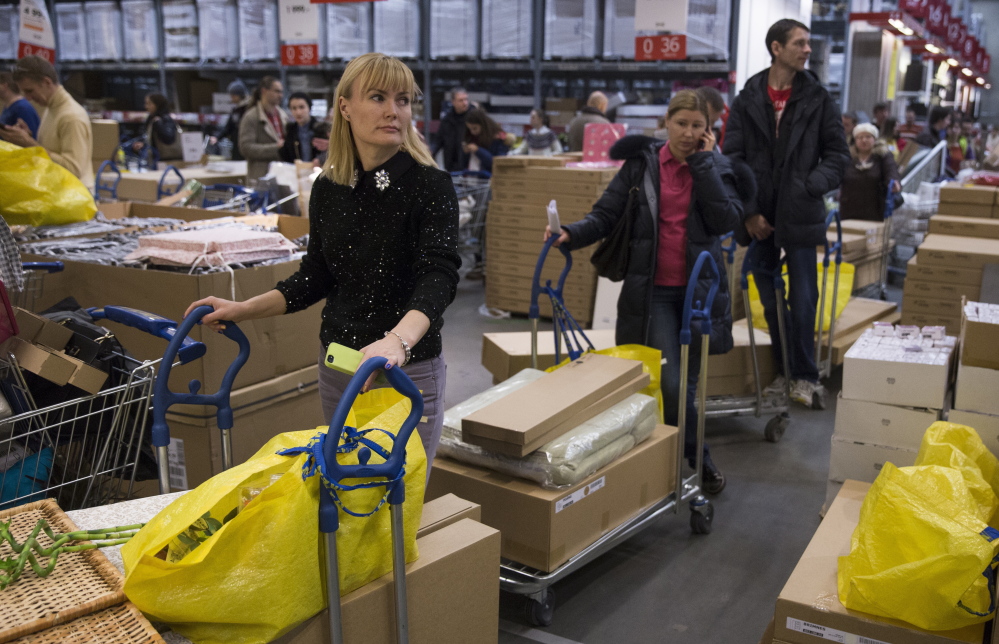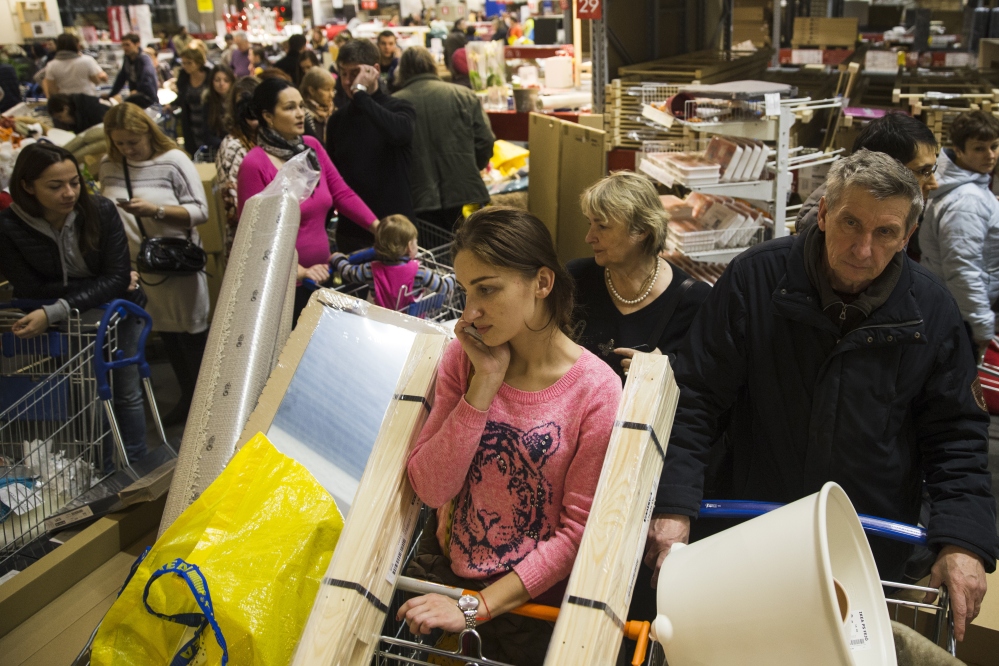MOSCOW — Russian consumers flocked to the stores Wednesday, frantically buying a range of big-ticket items to pre-empt the price rises kicked off by the staggering fall in the value of the ruble in recent days.
As Russian authorities announced a series of measures to ease the pressure on the ruble, which slid 15 percent in the previous two days and raised fears of a bank run, many Russians were buying cars and home appliances – in some cases in record numbers – before prices for these imported goods shoot higher.
The Swedish furniture giant Ikea already warned Russian consumers that its prices will rise Thursday, which resulted in weekend-like crowds at a Moscow store on a Wednesday afternoon.
Shops selling a broad range of items were reporting record sales – some have even suspended operations, unsure of how far the ruble will sink. Apple, for one, has halted all online sales in Russia.
“This is a very dangerous situation. We are just a few days away from a full-blown run on the banks,” Russia’s leading business daily Vedomosti said in an editorial Wednesday. “If one does not calm down the currency market right now, the banking system will need robust emergency care.”
Alyona Korsuntseva, a shopper at Ikea, said the current jitters surrounding the Russian economy reminded her of the 1998 Russian crisis when the ruble tumbled following the government’s default on sovereign bonds.
“What’s pressuring us is the fact that many people (back then) rushed to withdraw money from bank cards, accounts,” she says. “We want to safeguard ourselves so that things wouldn’t be as bad they were back then.”
Consumers are buying durable goods as they are seen as better investments than most Russian stocks.
And, an overwhelming majority of Russians cannot afford to buy land or real estate.
Earlier this week, the ruble suffered catastrophic losses as traders continued to fret over the combined impact of low oil prices and Western sanctions over Russia’s involvement in Ukraine’s crisis.
Some signs emerged Wednesday that the ruble’s free fall may have come to an end and the currency could recover, at least in the short term. After posting fresh losses early Wednesday, the ruble rallied more than 10 percent to around 60 per dollar at 9 p.m. Moscow time.
Analysts credited a series of reassuring statements from the Central Bank and the government for the improving ruble backdrop.
First, Deputy Finance Minister Alexei Moiseyev said the government will sell foreign currency from its own reserves “as much as necessary and as long as necessary.”
Then the Central Bank announced an expanded series of measures to help calm the situation, such as giving banks more freedom to increase interest rates on retail deposits and offering them more flexibility to deal with the ruble’s depreciation on their balance sheets.
Neil Shearing, chief emerging markets economist at London-based Capital Economics, said the “authorities have at last started to develop a strategy for containing the effects of the ruble’s collapse on the banking system and wider economy.”
The ruble’s tailspin continued Tuesday, despite a surprise move by Russia’s Central Bank to raise its benchmark interest rate to 17 percent from 10.5 percent – a move aimed to make it more attractive for currency traders to hold onto their rubles.
Should the current attempts to shore up the ruble fail, then the Russian authorities could be imposing capital controls.
Send questions/comments to the editors.




Success. Please wait for the page to reload. If the page does not reload within 5 seconds, please refresh the page.
Enter your email and password to access comments.
Hi, to comment on stories you must . This profile is in addition to your subscription and website login.
Already have a commenting profile? .
Invalid username/password.
Please check your email to confirm and complete your registration.
Only subscribers are eligible to post comments. Please subscribe or login first for digital access. Here’s why.
Use the form below to reset your password. When you've submitted your account email, we will send an email with a reset code.